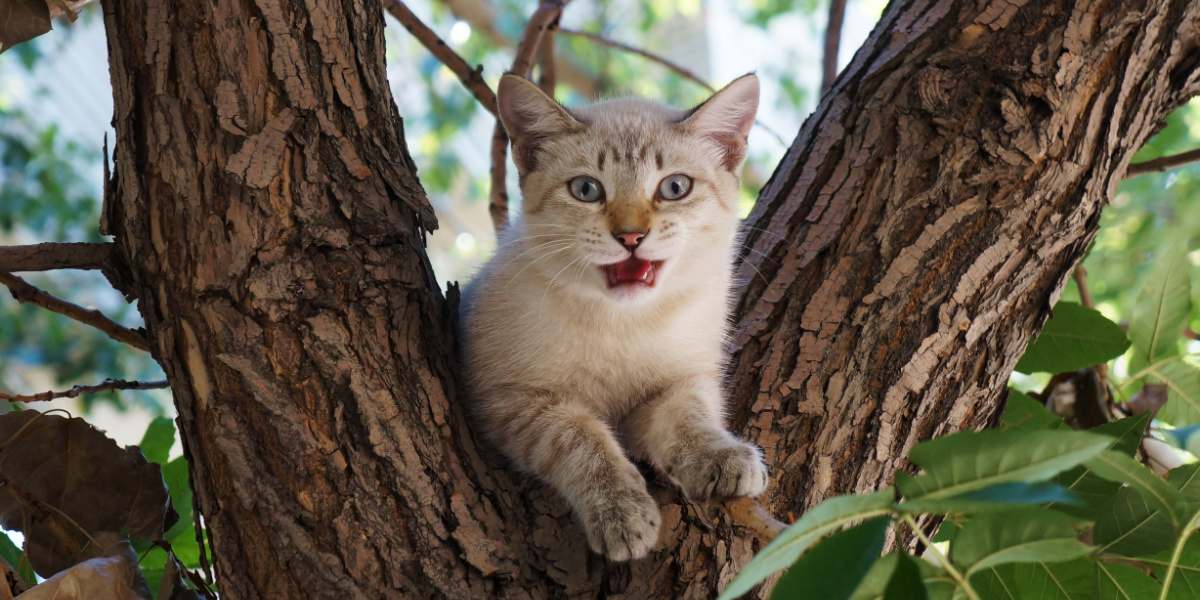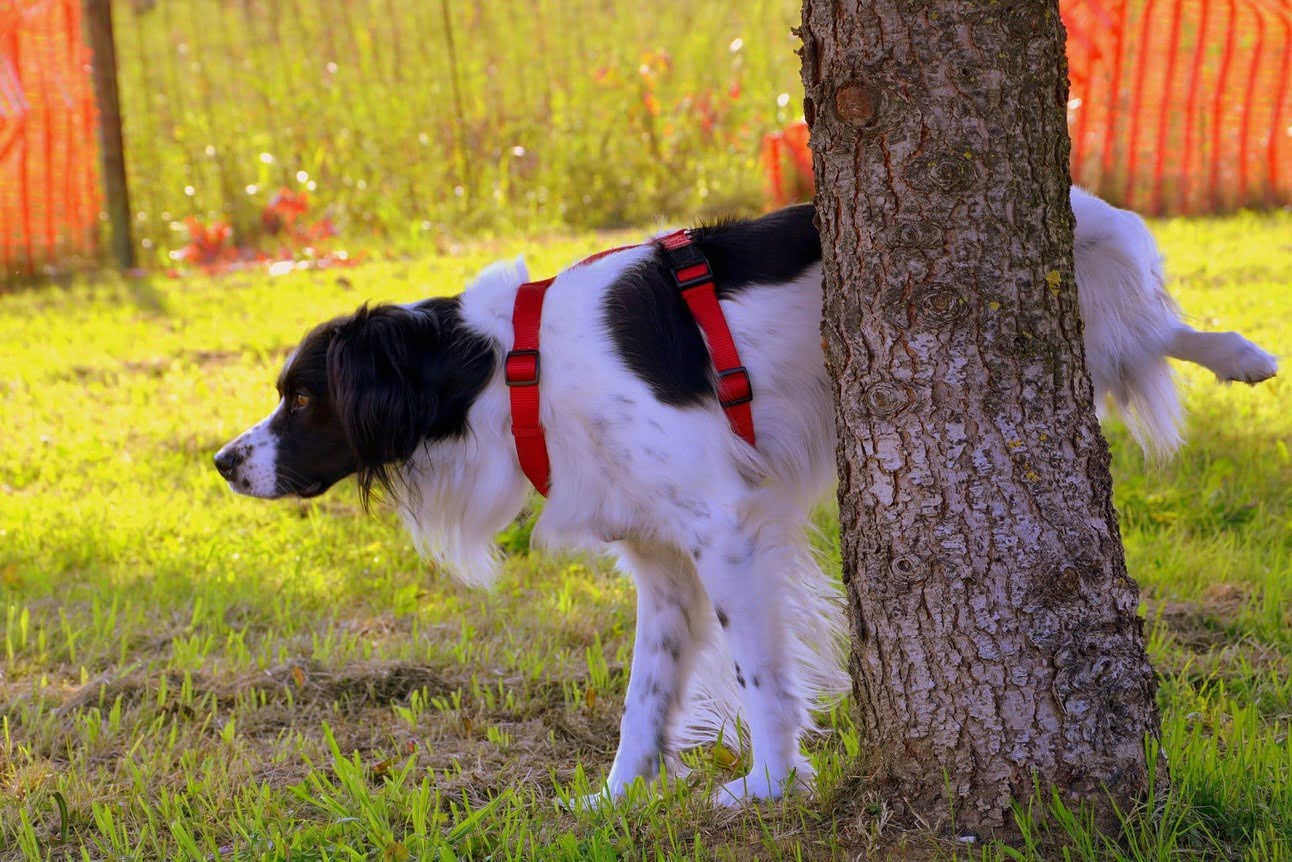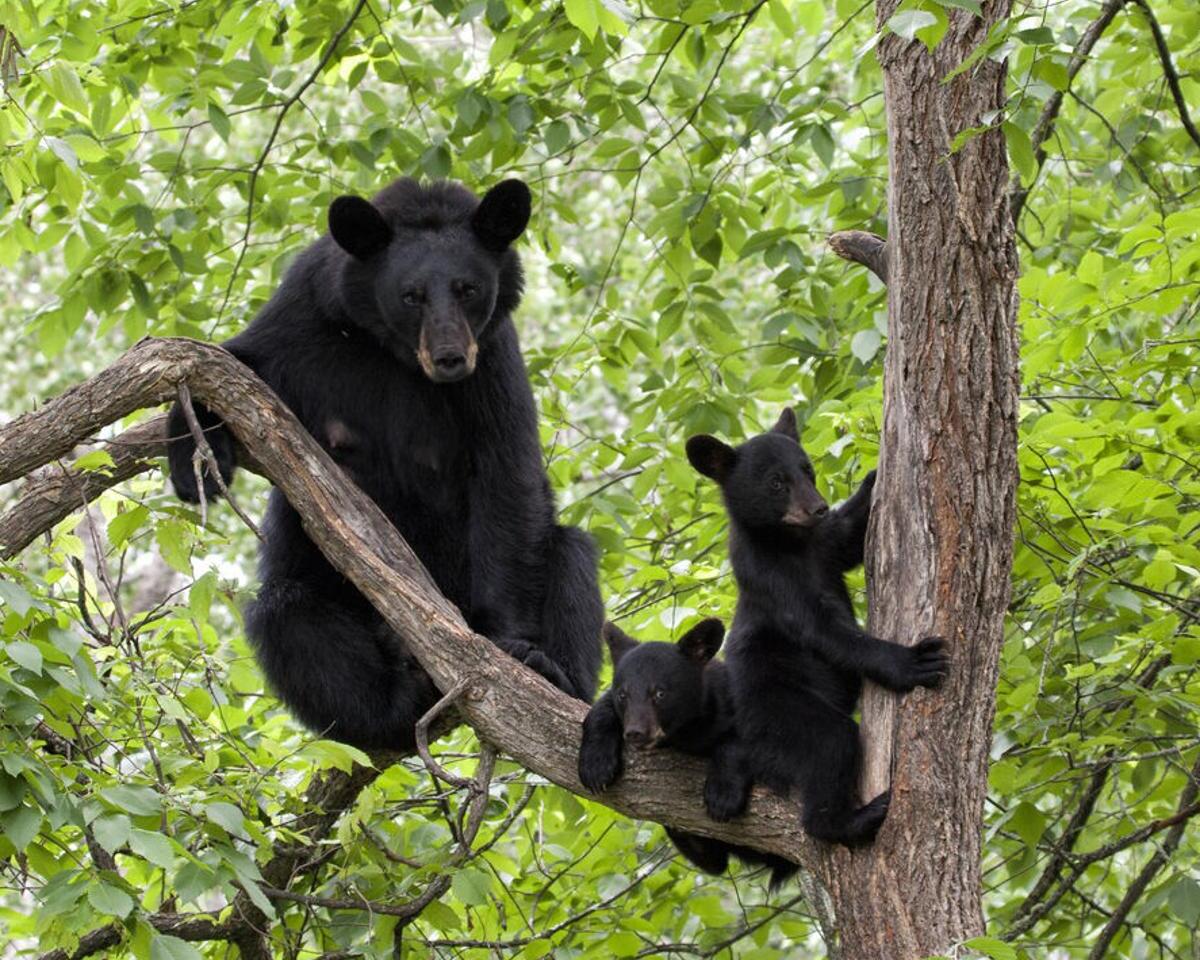Home>Gardening News and Trends>Latest News>Why Do Cats Get Stuck In Trees


Latest News
Why Do Cats Get Stuck In Trees
Published: October 23, 2023
Discover the latest news on why cats often get stuck in trees and learn what you can do to help them safely return to the ground.
(Many of the links in this article redirect to a specific reviewed product. Your purchase of these products through affiliate links helps to generate commission for Chicagolandgardening.com, at no extra cost. Learn more)
Table of Contents
- Introduction
- A Brief Overview of Cats’ Tree Climbing Abilities
- Common Reasons Cats Get Stuck in Trees
- The Psychological Aspect: Why Cats Might Refuse to Come Down
- The Physical Challenges of Descending from Trees
- The Role of Fear in Cat Tree Rescues
- The Importance of Professional Help in Getting Cats Down Safely
- Prevention and Precautionary Measures
- Conclusion
Introduction
Cats are known for their incredible agility and climbing abilities, effortlessly maneuvering their way up trees with grace and ease. However, it’s not uncommon to see a cat stuck high up in a tree, seemingly unable or unwilling to make its way back to solid ground. This perplexing situation raises several questions about why cats get stuck in trees and why they often require human intervention to come down safely.
In this article, we will explore the fascinating world of cats and trees, delving into the reasons behind this peculiar behavior. From psychological factors to physical challenges, we will uncover the complexities that contribute to cats finding themselves in these precarious situations. Furthermore, we will discuss the importance of professional help in rescuing a cat stuck in a tree and highlight some preventive measures to minimize such incidents.
Understanding why cats get stuck in trees is crucial for pet owners and animal lovers alike. By gaining insights into their behavior and the challenges they face, we can better empathize with these feline companions and take appropriate action when needed. So, let’s dive into the world of cats stuck in trees and unravel the mysteries that surround their captivating yet frustrating predicament.
A Brief Overview of Cats’ Tree Climbing Abilities
Cats are natural climbers, thanks to their unique anatomy and instinctual abilities. From a young age, kittens start exploring their surroundings and honing their climbing skills. This innate talent is rooted in their evolutionary history as arboreal creatures.
One of the main reasons cats excel at climbing is their powerful hind legs, which provide them with strong muscular support and propulsion. Their sharp claws act as grappling hooks, allowing them to grip onto tree trunks, branches, and other surfaces with precision and agility. Additionally, cats possess a flexible spine and shoulders, granting them the ability to navigate through tight spaces and maintain balance while perched on branches.
Climbing serves several purposes for cats. In the wild, it allows them to escape predators, seek refuge, and access hunting grounds. Domestic cats also exhibit these climbing instincts, even though their environment may not present the same survival challenges. Climbing provides cats with a sense of security, as they can retreat to higher vantage points to observe their surroundings safely.
Not only can cats climb vertically, but they can also move horizontally on branches, exhibiting a remarkable level of dexterity. This ability allows them to navigate complex tree structures and explore their surroundings with ease. They can jump from branch to branch, leap onto rooftops, and even climb down headfirst through a process called “limb walking.”
It’s important to note that not all cats have equal tree-climbing abilities. Factors such as age, size, weight, and physical health can influence their climbing prowess. Older or overweight cats may find it more challenging to climb trees and maneuver through the branches effectively.
In essence, a cat’s tree climbing abilities are a testament to their remarkable physical attributes and innate instincts. However, despite their natural talents, cats sometimes find themselves stuck in trees, unable to descend on their own. In the following sections, we will explore the various reasons why cats encounter difficulties when descending from trees and the psychological factors at play.
Common Reasons Cats Get Stuck in Trees
While cats are skilled climbers, there are several common reasons why they may find themselves unable or unwilling to come down from trees:
- Fear and Distress: Cats may become frightened or startled by a loud noise, unfamiliar sights, or the presence of predators such as dogs. In their state of fear, they may retreat to the safety of a tree but find it difficult to calm down and make their way back down.
- Chasing Prey: Cats are natural hunters, and they may climb trees in pursuit of small animals, such as birds or squirrels. While their climbing abilities help them reach potential prey, their focus on the hunt sometimes causes them to forget how to navigate back down.
- Territorial Behavior: Cats are known for marking their territory, and climbing trees is one way they establish dominance and assert their presence. However, disputes with neighboring cats or territorial challenges can lead to cats getting stranded in trees until the conflict subsides.
- Curiosity: Cats are famously curious creatures, and their innate curiosity can sometimes lead them to climb higher than they can safely descend. They may climb trees to investigate intriguing sounds, movements, or objects, only to find themselves in a precarious situation higher up the branches.
- Enclosed Spaces: Cats may climb trees to escape from enclosed spaces, such as a fenced backyard or a room with closed doors. When faced with a perceived threat or confinement, they instinctively seek higher ground as a means of escape.
It’s important to note that each cat’s situation is unique, and the reasons for being stuck in a tree can vary from one feline to another. Understanding these common reasons can help pet owners and rescuers approach the situation with empathy and determine the appropriate course of action to safely bring the cat back down to the ground.
The Psychological Aspect: Why Cats Might Refuse to Come Down
When a cat is stuck in a tree, it’s not always a matter of physical inability to descend. Sometimes, there are psychological factors at play that contribute to their hesitation or refusal to come down:
- Perceived Threat: Cats have a heightened sense of awareness, and being up in a tree gives them a feeling of safety from potential threats on the ground. Descending may expose them to perceived dangers, such as other animals or unfamiliar surroundings, causing them to stay put in their elevated perch.
- Anxiety and Stress: The stress of being stuck in a tree can cause cats to experience anxiety. The unfamiliar environment, combined with the inability to come down on their own, can lead to heightened stress levels. This anxiety can further exacerbate their reluctance to make the descent.
- Lack of Confidence: Some cats may lack the confidence or experience needed to navigate tree branches effectively. They may feel unsure of their footing or fear losing balance during the descent. This lack of confidence can keep them stuck in the tree until intervention is provided.
- Attachment to Height: Cats derive a sense of security and comfort from being in high places. The height of a tree offers them a vantage point to observe their surroundings and a sense of control over their environment. This attachment to height may make them hesitant to come down, as they prefer the elevated position over being on the ground.
- Past Negative Experiences: Cats’ behavior can be influenced by past experiences. If a cat has had a negative encounter or trauma while on the ground, they may associate it with being closer to the ground. In such cases, they may choose to stay up in the tree as a way to avoid reliving those negative experiences.
Understanding the psychological aspects that impact a cat’s willingness to come down from a tree is crucial for safe and effective rescue operations. It requires patience, compassion, and an understanding of the individual cat’s temperament. By addressing these psychological factors, rescuers can help create a less stressful environment for the cat and increase the chances of a successful descent.
The Physical Challenges of Descending from Trees
While cats are adept climbers, descending from a tree presents its own set of challenges. Despite their natural abilities, certain physical factors can make the descent more difficult for cats:
- Narrow Branches: As cats climb higher, the branches tend to become narrower and less stable. This can make it harder for them to find secure footing and maintain balance during the descent.
- Lack of Gripping Surfaces: Unlike climbing up, going down a tree requires cats to rely on their claws to slow down and control their descent. However, smooth branches or bark may not provide enough traction, making it harder for them to grip and safely navigate downwards.
- Branch Flexibility: As cats move down a tree, the branches they encounter may bend or sway under their weight. This movement can unsettle cats and make them feel uncertain about their ability to safely reach the ground.
- Fear of Falling: Cats have a natural fear of heights, and as they descend, they may become more aware of the distance between themselves and the ground. This fear can make them hesitant to continue their descent, as they may be uncertain about their ability to land safely.
- Fatigue and Muscle Fatigue: Climbing requires significant physical effort, and cats may become tired or experience muscle fatigue during prolonged periods stuck in a tree. This physical exhaustion can make it even more challenging for them to muster the strength and coordination necessary for a successful descent.
It’s important to consider these physical challenges when attempting to rescue a cat from a tree. Rushing the process or applying forceful methods can increase the risk of injury to both the cat and the rescuer. Careful planning, patience, and a keen understanding of feline behavior are essential to ensure a safe and successful return to the ground.
The Role of Fear in Cat Tree Rescues
Fear plays a significant role in cat tree rescues, both for the cat itself and the individuals attempting to assist in their safe return to the ground. Understanding and managing fear is crucial to ensuring a successful rescue operation:
- Fear-Based Behavior: When cats are stuck in trees, fear can influence their behavior and responses. They may become defensive, aggressive, or attempt to hide deeper within the branches. Additionally, fear can cause them to be more easily startled or reactive, making it difficult to approach them without triggering an escalation of fear-based behaviors.
- Rescuer Fear: Rescuers also face their own fears during cat tree rescues. The height, uncertain terrain, and potential risks involved can trigger anxiety and fear. Rescuers must remain calm and composed to create an environment that reassures the cat and minimizes the chances of accidents or injuries during the rescue operation.
- Heightened Fear Response: Cats stuck in trees may experience heightened fear due to their unfamiliar surroundings and the inability to access the ground. This heightened fear response can intensify their reluctance or unwillingness to cooperate with rescue efforts, making it more challenging for rescuers to safely retrieve them.
- Positive Reinforcement: The role of fear in cat tree rescues highlights the importance of using positive reinforcement techniques. Rescuers can utilize treats, familiar scents, and soothing voices to help establish a sense of trust and alleviate the cat’s fear. This positive reinforcement approach can encourage the cat to approach the rescuer and facilitate a smoother and safer rescue process.
- Patience and Empathy: Fear can prolong the rescue process, requiring rescuers to exercise patience and empathy. Rushing the cat or applying forceful techniques can heighten their fear response and make the situation more dangerous. By understanding the cat’s perspective and allowing them time to feel more secure, rescuers can build trust and increase the likelihood of a successful rescue.
Managing and addressing fear is a crucial aspect of cat tree rescues. Through a combination of gentle and patient approaches, positive reinforcement, and a deep understanding of feline behavior, rescuers can help alleviate fear and create a safe and secure environment for both the cat and the individuals involved in the rescue operation.
The Importance of Professional Help in Getting Cats Down Safely
When a cat is stuck in a tree, it may be tempting for pet owners or well-meaning individuals to attempt a rescue themselves. However, seeking professional help is crucial for ensuring the safety of both the cat and those involved in the rescue. Here’s why professional assistance is important:
- Training and Experience: Professional animal rescue organizations or trained individuals have the necessary expertise and experience in handling cat tree rescues. They understand the complexities involved and are equipped with the skills and knowledge to navigate challenging situations safely.
- Safety Considerations: Climbing trees can be dangerous for both the cat and individuals attempting to rescue them. Professional rescuers are trained to assess risks, use appropriate safety equipment, and implement proper protocols to minimize the chances of accidents or injuries during the rescue operation.
- Specialized Equipment: Professional rescuers have access to specialized equipment specifically designed for cat tree rescues. This can include advanced climbing gear, safety harnesses, and rescue bags or baskets. Such equipment helps ensure the safe retrieval and transport of the cat from the tree to the ground.
- Behavioral Understanding: Professionals have a deep understanding of feline behavior and can assess the cat’s temperament and emotional state during the rescue. This knowledge allows them to adapt their approach and use appropriate techniques to calm the cat, reducing stress and facilitating a successful rescue.
- Minimizing Trauma: Rescuing a cat from a tree can be a traumatic experience for both the cat and the individuals involved. Professional rescuers prioritize the physical and emotional well-being of the cat, employing methods and strategies to minimize stress and trauma during the rescue operation.
- Emergency Preparedness: In rare cases where a cat is stuck in a dangerous or high-risk situation, professional rescuers are equipped to handle emergencies. They have contingency plans in place and can swiftly respond to unforeseen challenges or complications that may arise during the rescue process.
While the instinct to help a cat stuck in a tree is commendable, it’s vital to recognize the limitations and risks involved. Seeking professional help ensures that the rescue operation is conducted safely and effectively, maximizing the chances of a successful reunion between the cat and their grateful owner.
Prevention and Precautionary Measures
Preventing cats from getting stuck in trees is an ideal approach to avoid the stress and potential risks associated with rescues. Here are some prevention and precautionary measures pet owners can undertake:
- Provide Indoor Enrichment: Creating a stimulating indoor environment with climbing structures, scratching posts, and interactive toys can satisfy a cat’s natural climbing instincts and reduce their desire to venture outside for tree climbing.
- Supervise Outdoor Time: If you allow your cat outdoor access, closely supervise them during their outdoor excursions. Regularly check on them to ensure they haven’t climbed too high and are not in any distress.
- Secure Fenced Yards: If you have a fenced yard, make sure there are no gaps or openings that cats can squeeze through. Additionally, consider adding deterrents like cat-proofing rollers or netting to prevent climbing over the fences.
- Use Cat Enclosures or Catio: Providing a cat enclosure or catio serves as a safe and controlled outdoor space where cats can enjoy fresh air and the sights and sounds of nature without the risk of climbing trees.
- Train Recall Commands: Teaching your cat recall commands can be helpful in bringing them back to safety if they do venture up a tree. Training them to come when called can also reduce the chances of them getting stuck.
- Identify Escape Routes: Take note of potential escape routes in your yard to help guide your cat down from a tree if they do get stuck. Ensure there are easily accessible paths or ramps that lead back to the ground.
- Microchip and ID Tags: Ensure your cat has a microchip with updated information and wears a collar with identification tags. This increases the chances of a safe return if they wander off or get stuck in a tree while exploring unfamiliar areas.
By implementing these preventive measures, pet owners can minimize the likelihood of their cats getting stuck in trees. However, accidents can still happen, and it’s crucial to remain calm and seek professional help if your cat becomes stranded in a tree.
Conclusion
Cats getting stuck in trees is not an uncommon occurrence, despite their remarkable climbing abilities. Understanding the reasons behind this predicament, both psychological and physical, sheds light on the complexities that contribute to cats finding themselves in these challenging situations. Fear, both for the cat and the rescuers, plays a significant role in the rescue process, emphasizing the importance of professional assistance for a safe and successful retrieval.
Preventing cats from getting stuck in trees should be a priority for pet owners, and implementing precautionary measures can significantly reduce the chances of such incidents. Creating an enriching indoor environment, closely supervising outdoor time, securing yards, and training recall commands can all contribute to a safer environment for our feline companions.
In the event that a cat does find itself stranded in a tree, seeking professional help is crucial. Trained individuals possess the expertise, experience, and specialized equipment necessary to conduct a smooth and safe rescue operation, while also considering the psychological well-being of the cat.
By understanding the behaviors, challenges, and preventive measures associated with cats and trees, we can appreciate the intricate nature of this phenomenon. Through empathy, patience, and a commitment to providing the best care for cats, we can ensure their safety and well-being, whether they decide to climb up a tree or explore the world from the comfort of solid ground.










